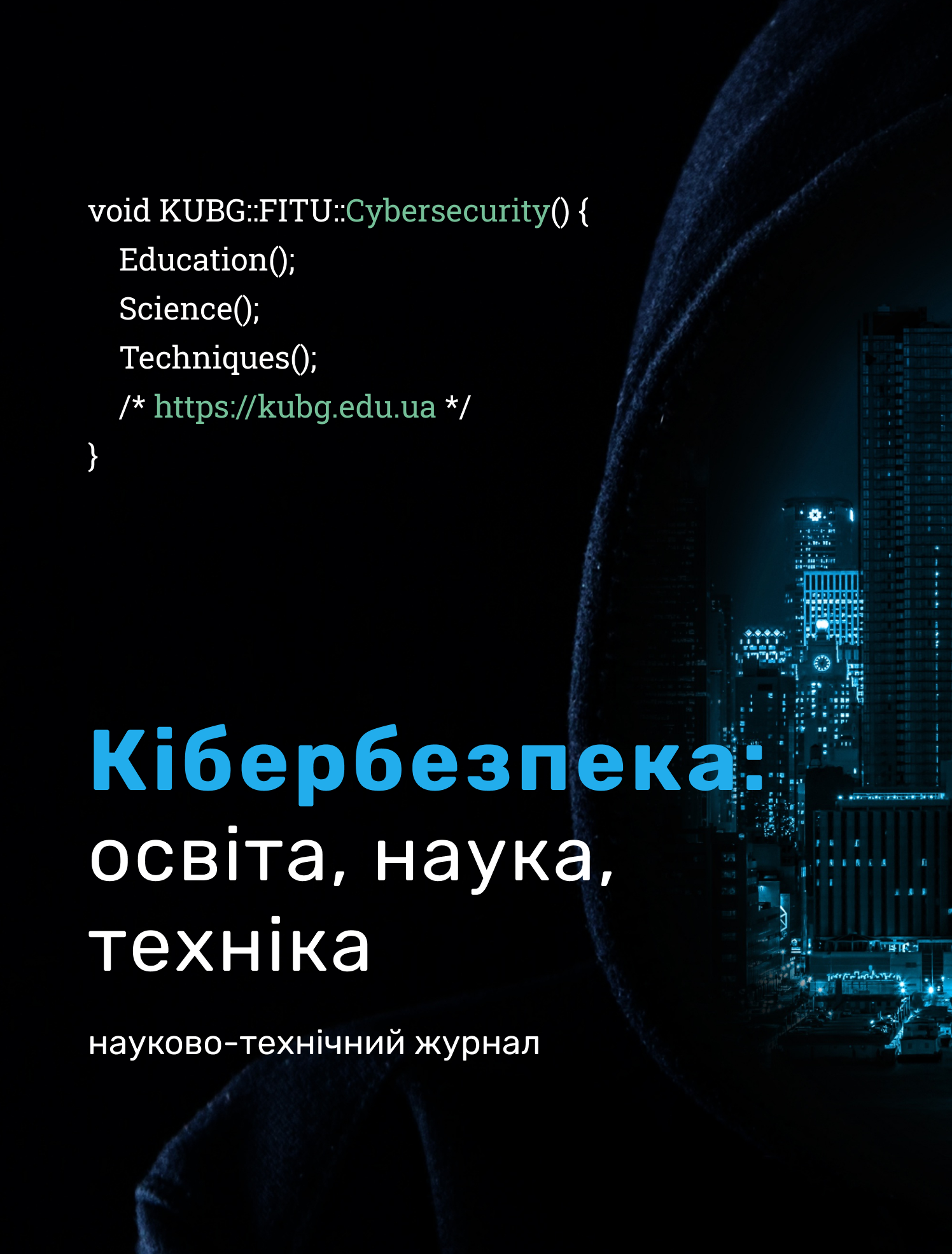МОДИФІКАЦІЯ КРИПТОГРАФІЧНОГО АЛГОРИТМУ А5/1 ДЛЯ ЗАБЕЗПЕЧЕННЯ КОМУНІКАЦІЙ ПРИСТРОЇВ IOT
DOI:
https://doi.org/10.28925/2663-4023.2023.20.253271Ключові слова:
Інтернет речей; криптографічний захист; A5/1; пристрої з обмеженими обчислювальними ресурсами; алгоритми шифрування; ефективність; конфіденційність; модель загроз.Анотація
Мережі інтернету речей є високо диверсифікованими з точки зору великої кількості пристроїв з різними характеристиками, операційних систем, алгоритмів захисту, протоколів передачі інформації. Криптографічні алгоритми не можуть однаково добре функціонувати на різних пристроях, більшість з них демонструє низькі показники швидкості шифрування та високі вимоги до пам’яті на 8-бітних пристроях класу С0. У статті розглядається модифікація криптографічного алгоритму A5/1 для застосування в мережах інтернету речей 8-бітними пристроями з обмеженими обчислювальними ресурсами. Сформовано модель загроз в якій визначено основні загрози та можливі методи для їх нейтралізації, зокрема методи криптографічного захисту. За рахунок розробленої модифікації вдалось усунути основні недоліки А5/1 у випадку застосування для захисту інформації в мережах інтернету речей, зокрема збільшити довжину ключа, підвищити імітостійкість, оптимізувати до використання на 8-бітних пристроях. Запропоновані заміни бітової обробки даних на байтову дозволили покращити криптографічні якості і підвищити зручність застосування алгоритму на пристроях з обмеженими обчислювальними ресурсами. За результатами статистичних тестів шифруюча послідовність може вважатись випадковою рівномірно розподіленою. Для застосування модифікованого алгоритму було побудовано криптографічний протокол з методами ідентифікації пристроїв та безпечного управління ключами. Запропоновані рішення були практично реалізовані та апробовані та досягнута прийнятна швидкість шифрування для багатьох застосувань на 8-бітному пристрої.
Завантаження
Посилання
Rahman, M. S., Karnik, S., & Sarangerel, S. (2022). Lightweight Cryptography. MIT Course Project. Retrieved from https://courses.csail.mit.edu/6.857/2022/projects/Shahir-Rahman-Karnik-Sarangerel.pdf
Pradhan, D., & Tun, H. (2022). Security Challenges: M2M Communication in IoT. Journal of Electrical Engineering and Automation, 4, 187-199. https://doi.org/10.36548/jeea.2022.3.006
Mhaibes, H. I., Abood, M. H., & Farhan, A. (2022). Simple Lightweight Cryptographic Algorithm to Secure Embedded IoT Devices. International Journal of Interactive Mobile Technologies (iJIM), 16(20), 98–113. https://doi.org/10.3991/ijim.v16i20.34505
Al-Shargabi, B., & Dar Assi, A. (2023). A modified lightweight DNA-based cryptography method for Internet of Things devices. Expert Systems, 40(6), e13270. https://doi.org/10.1111/exsy.13270
Final report of European project number IST-1999-12324, named New European Schemes for Signatures, Integrity, and Encryption. Springer-Verlag, Berlin Heidelberg NewYork, etc. 2004, NESSIE public report D20. NESSIE Security Report. http://cryptonessie.org.
Daemen, J. Rijmen V. (1998) "AES Proposal: Rijndael," AES Round 1 Technical Evaluation CD1: Documentation, National Institute of Standards and Technology, Aug 1998. http://www.nist.gov/aes.
Horbenko I. D., Horbenko Yu. I. (2012) Applied Cryptology: monograph. – Kharkiv, KhNURE, Fort, 2012. – 868 p.
Kuznetsov O. O. et al. (2014) Substantiation of requirements, construction, and analysis of promising symmetric cryptographic transformations based on block ciphers. URL: https://science.lpnu.ua/sites/default/files/journal-paper/2017/nov/6634/21-124-141.pdf
Buhantsov A.D., Sadjiid A.Yu., Ustinov A.N., Rodionov C.V. (2021) Research of speech encryption reliability in GSM mobile communication technology. Research result. Information technologies. – vol.6, №2, 2021. P. 9-17. DOI: 10.18413/2518-1092-2021-6-2-0-2
Xu, Y., Hao, Y., & Wang, M. (2023). Revisit two memoryless state‐recovery cryptanalysis methods on A5/1. IET Information Security, 17. https://doi.org/10.1049/ise2.12120.
Glukhov M., Elizarov V., Nechaev A. (2003) Algebra, vol. 2, Gelios APB, 2003. 416 p. ISBN8-85338-072-2
Buryachok V. L., Gulak G.M., Skladannyy P. M. (2017) Fast algorithm for generating substitutions of a multialphabetic substitution. Information security. 2017. №2. P. 173–177.
Gulak G.M., Skladannyy P.M. (2017) Ensuring reliability of automated control and data transmission systems of unmanned aerial vehicles. Mathematical machines and systems. 2017. № 3. P. 154–161.
Shannon C. (1949) Communication Theory of Secrecy Systems / Bell System Technical J. 1949. vol. 28. P. 656–715.
Massey J.L., Maurer U., and Wang M. Non-Expanding (1988) Key-Minimal, Robustly-Perfect, Linear and Bilinear Ciphers. Adv. Cryptology EUROCRYPT’87. Berlin; Heidelberg: Springer Verlag, 1988. P. 237–247.
Gulak G., Kovalchuk L. (2001) Different approaches to defining random sequences / Legal, regulatory, and metrological support of the information protection system in Ukraine. – Kyiv, 2001. Issue 3. P.127–133.
Special publication NIST SP 800-22A (2010) Statistical Test Suite for Random and Pseudorandom Number Generators for Cryptographic Applications. URL: https://nvlpubs.nist.gov/nistpubs/legacy/sp/nistspecialpublication800-22r1a.pdf
Kristinsson, B. (2011). Ardrand: The Arduino as a Hardware Random-Number Generator. Retrieved from https://api.semanticscholar.org/CorpusID:195592641
J. Hoffstein, J. Pipher, J.H. Silverman. (2014) An introduction to mathematical cryptography. – Springer. 2014. – 523 p. ISBN 978-1-4939-1711-2
Bessalov A.V. Elliptic curves in Edwards form and cryptography: monograph. – Kyiv: IVC "Publishing House "Polytechnika"", 2017. – 272 p.
DSTU 9041:2020 Information technologies. Cryptographic protection of information. Algorithm for encrypting short messages based on twisted Edwards elliptic curves (2020). Retrieved from: http://online.budstandart.com/ua/catalog/doc-page.html?id_doc=90523
Kulasekara, V., Balasooriya, S., Chandran, J., & Kavalchuk, I. Novel low-power NRF24L01 based wireless network design for autonomous robots. In 2019 25th Asia-Pacific Conference on Communications (APCC), 2019 (pp. 342-346): IEEE
A security mechanism for Enhanced ShockBurst wireless communication protocol using nRF24L01. https://doi.org/10.21203/rs.3.rs-3777984/v1
Rivera, D., García, A., Martín-Ruiz, M. L., Alarcos, B., Velasco, J. R., & Oliva, A. G. (2019). Secure communications and protected data for an Internet of Things smart toy platform. IEEE Internet of Things Journal, 6(2), 3785-3795.
Опубліковано
Як цитувати
Номер
Розділ
Ліцензія
Авторське право (c) 2023 Віктор Корнієць, Роман Черненко

Ця робота ліцензується відповідно до Creative Commons Attribution-NonCommercial-ShareAlike 4.0 International License.




